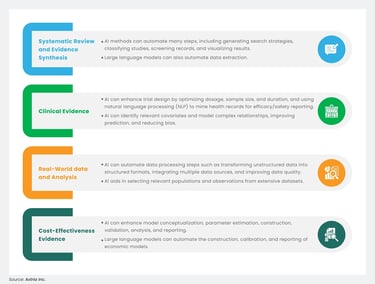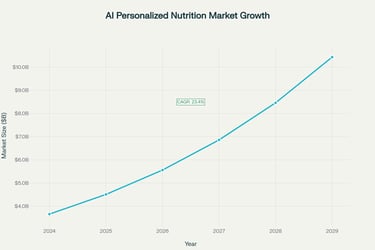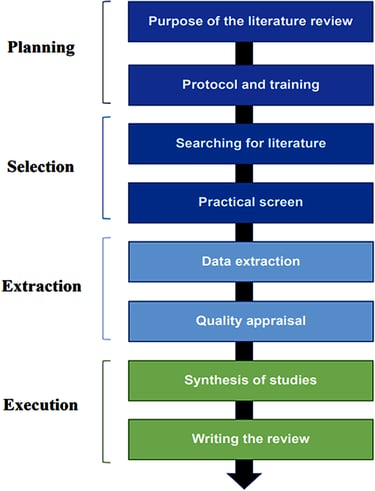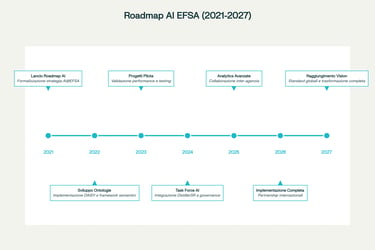Towards personalized nutrition of the future
The European Food Safety Authority has taken a pioneering role in integrating artificial intelligence into scientific assessment processes, setting a fundamental precedent for the responsible application of AI in the public sector. EFSA's strategy represents a paradigmatic model of how institutions can embrace technological innovation while maintaining scientific integrity, methodological rigor, and public trust—essential elements for the success of the nutritional ecosystem of the future.
Alessandro Drago
11/3/2025


EFSA's AI roadmap: Vision 2027
EFSA's AI roadmap, strategically launched in May 2021, represents an ambitious yet realistic vision for implementing artificial intelligence in evidence management by 2027. This initiative aims to significantly increase the accessibility and breadth of available scientific evidence, while simultaneously improving the reliability of the risk assessment process through the application of human-centric AI in close coexistence with human expertise.
EFSA's vision recognizes a fundamental truth: AI does not replace human judgment but amplifies and supports it, allowing scientists to process unprecedented volumes of data while maintaining critical control over decision-making processes. This approach balances technological efficiency with scientific responsibility, creating a model for the entire sector.
The systematic approach to AI implementation
EFSA's approach to AI integration is built on three fundamental pillars that define the future of technological integration in the public sector. These pillars represent not only technical components but elements of an integrated philosophy that balances innovation and responsibility.
The first pillar comprises ontologies and Big Data infrastructure for evidence management, enabling better categorization and accessibility of scientific information. EFSA is developing advanced semantic classification systems that allow for deeper understanding of relationships between different studies and scientific evidence. This includes developing structured data standards and interoperable formats that facilitate automated analysis and integration of diverse evidence sources.
The second pillar includes AI governance frameworks that ensure scientific integrity through rigorous validation and oversight protocols. EFSA has developed comprehensive internal guidelines that align AI use with EU recommendations, including those from the European Ombudsman and the European Data Protection Supervisor. These frameworks ensure that every AI application is subject to rigorous scientific review and continuous ethical oversight.
The third pillar is human-centric AI operating in coexistence with human expertise, where AI systems support and amplify human capabilities without replacing them. This approach ensures that final decisions remain under human control while leveraging AI's ability to process massive volumes of data and identify complex patterns that might escape traditional analysis.
EFSA's AI Task Force: operationalizing the strategy
In January 2024, EFSA established a dedicated AI Task Force to identify incremental actions that can be undertaken to harness the power of emerging AI technologies. The Task Force represents a pragmatic approach to innovation, focusing on concrete implementations that can demonstrate immediate value while building capacity for more ambitious future applications.
The Task Force operates on three main tasks that reflect a holistic approach to AI adoption.
The first task is to support the development of an internal network of interested colleagues, creating a community of practice that facilitates knowledge and experience sharing. This approach recognizes that AI adoption requires cultural as well as technological change, and that success depends on engagement and distributed expertise throughout the organization.
The second task is to identify IT investments necessary for AI adoption, including computing infrastructure, data management systems, and AI development platforms. EFSA recognizes that effective AI implementation requires significant investments in technology and infrastructure, but also that these investments must be strategically planned to maximize return and minimize risks.
The third task is to support the definition of internal guidelines aligned with recommendations and guidelines from relevant EU audit and control bodies. This ensures that EFSA's use of AI is fully aligned with European standards of governance and accountability, setting a precedent for other public institutions.
Practical implementations in evidence management
EFSA has identified specific AI application scenarios in evidence management that demonstrate the practical potential of AI-science integration. These scenarios range from automating routine processes to enhancing advanced analytical capabilities, showing how AI can transform every aspect of scientific work.
Intelligent automation of research processes
EFSA's practical applications range from automated data collection and terminological evaluation to keyword identification for systematic reviews, screening of relevant abstracts, literature de-duplication, and results clustering. These applications demonstrate how AI can significantly accelerate processes that traditionally required weeks or months of manual work.
EFSA's pioneering work with AI-assisted systematic reviews has shown efficiency gains of up to 90% while maintaining scientific quality. This success stems from implementing rigorous validation protocols that ensure AI automation does not compromise scientific integrity. EFSA has developed methodologies that allow human validation of AI results, creating hybrid systems that combine technological speed with scientific accuracy.
Automation also includes more sophisticated processes such as automatic identification of relevant studies in multiple languages, automatic extraction of structured data from scientific articles, and identification of potential biases or limitations in analyzed studies. These processes not only accelerate research but can also identify patterns and connections that might escape manual analysis.
Enhancement of scientific quality
Beyond efficiency, AI at EFSA also improves the quality of scientific research through identifying inconsistencies, cross-referential validation of results, and identification of gaps in available evidence. These systems can systematically analyze vast literatures, identifying emerging trends and areas requiring further research.
AI can also help identify potential conflicts of interest, problematic methodologies, or suspicious data in analyzed studies, supporting the quality assessment process that is central to EFSA's scientific credibility. These systems do not replace expert judgment but provide powerful tools to support informed decisions.
Practical applications: AI-EFSA integration in personalized nutrition
The integration of AI with EFSA's regulatory framework opens innovative possibilities for evidence-based personalized nutrition, creating a model for how advanced technology can serve the public interest while maintaining rigorous scientific standards.
Scientifically validated recommendation systems
AI-powered nutritional recommendation systems are reaching unprecedented levels of sophistication and accuracy when integrated with EFSA scientific frameworks. Recent studies demonstrate that these systems can achieve compliance rates exceeding 80% for dietary goals aligned with clinical guidelines such as DASH when designed with appropriate regulatory constraints.
These systems utilize sophisticated algorithms that integrate multiple data sources, including individual nutritional profiles, food preferences, medical restrictions, genetic and metabolic data. AI analyzes this data within the context of EFSA recommendations and European nutritional guidelines to generate personalized recommendations that are both effective and compliant with the most rigorous scientific standards.
A particularly innovative aspect of these systems is their ability to perform automatic cross-referencing of ingredient lists against Novel Food regulations, validate health claims against the approved EFSA database in real-time, ensure nutritional adequacy using established Dietary Reference Values, and generate complete audit trails for regulatory compliance documentation.
Nutrient-AI Interaction Models
The most advanced AI-powered systems now employ sophisticated nutrient interaction models, using Graph Neural Networks to predict positive and negative interactions between ingredients. These models represent a qualitative leap in understanding complex nutritional interactions, enabling the creation of recommendations that consider synergies and antagonisms between different nutrients.
Graph Neural Networks are particularly suited for modeling nutritional interactions because they can capture non-linear and multi-dimensional relationships between nutrients, ingredients, and health outcomes. These models can identify beneficial synergies between nutrients that amplify positive effects or antagonisms that may reduce effectiveness, crucial information for optimal nutritional product formulation.
Practical implementation of these models includes formulation optimization systems that can modify product compositions in real-time based on aggregated consumer response data, always maintaining regulatory compliance. These systems represent the future of personalized nutrition, where formulations are continuously optimized based on scientifically validated real-world feedback.
The Challenge of Consumer Trust in the AI Era
Building consumer trust in nutritional AI requires a multifaceted approach that integrates technological transparency, scientific rigor, and effective communication. EFSA's experience provides valuable insights on how institutions can build and maintain public trust while innovating technologically.
Consumer education and AI literacy
EFSA recognizes that successful AI adoption in food systems requires not only advanced technology but also comprehensive consumer education. The authority is developing educational programs that explain how AI is used in risk assessment processes, what benefits it offers, and what safeguards are in place to protect consumers.
These programs include educational materials accessible to the general public, interactive webinars, and collaborations with consumer organizations to disseminate accurate information about AI in food safety. The goal is to create an informed population that can make conscious decisions about using AI-enhanced products and services.
Education also includes training for health and nutrition professionals who must understand how to interpret and use recommendations generated by AI systems. EFSA is developing specific curricula that combine traditional nutritional competencies with AI literacy skills, preparing the next generation of professionals for the era of intelligent nutrition.
Building trust through transparency
EFSA's strategy for building trust is based on complete transparency regarding the AI processes used. This includes publishing artificial intelligence methodologies, explanations of datasets used, descriptions of validation processes, and documentation of AI system limitations.
EFSA regularly publishes reports documenting how AI is used in its processes, which decisions are supported by artificial intelligence, and which remain under exclusive human control. This transparency not only builds trust but also establishes best practices that other organizations can follow.
Transparency also includes proactive engagement with media and stakeholders to explain AI developments and respond to public concerns. EFSA maintains open dialogue with consumer groups, scientific communities, and industry stakeholders to ensure that AI implementation responds to real needs and addresses legitimate concerns.
Personalized Nutrition Ecosystem: Converging Technologies
Successful integration of AI in personalized nutrition requires the convergence of multiple advanced technologies, creating an integrated ecosystem that can provide precise, safe, and personalized recommendations at scale.
Integration with Wearable Technologies and IoT
The future of personalized nutrition depends on seamless integration between AI systems and wearable technologies that can continuously monitor relevant biomarkers. EFSA is exploring how this real-time data can be integrated into its risk assessment frameworks to create more accurate and timely recommendations.
Wearable devices can monitor parameters such as glucose levels, heart rate variability, sleep patterns, physical activity, and hydration status, providing a continuous data stream that AI systems can use to adapt nutritional recommendations in real-time. This capability represents a fundamental shift from static recommendations based on general populations toward truly personalized guidance based on individual physiology.
Integration also includes smart kitchen appliances and food monitoring applications that can automatically track food intake and provide immediate feedback on nutritional choices. These systems create closed-loop feedback mechanisms that enable continuous optimization of recommendations based on actual consumption patterns and physiological responses.
Genomics and targeted Nutrition
The integration of AI with genomic data represents the most promising frontier of personalized nutrition. EFSA is investigating how genetic information can be safely and effectively integrated into its frameworks to provide recommendations that consider individual genetic predispositions toward certain nutrients or food components.
Genomic AI applications can identify individuals who are more likely to benefit from specific nutritional interventions or who might be at risk of adverse reactions to certain foods. This information can guide personalized dietary recommendations that are both effective and safe for individual consumers.
Implementation includes developing secure systems to manage sensitive genetic data, creating algorithms that can interpret complex genomic interactions, and defining ethical guidelines for using genetic information in nutritional recommendations.
Emerging Challenges and Future Preparedness
Successful implementation of AI in personalized nutrition presents multiple challenges that require proactive preparation and innovative solutions. EFSA is actively addressing these challenges through research programs, stakeholder engagement, and policy development.
Data Privacy and Security
Protecting sensitive health and nutritional data represents one of the most critical challenges in nutritional AI implementation. EFSA is developing comprehensive frameworks to ensure that AI systems meet the highest data privacy standards while enabling beneficial innovations.
This includes developing federated learning approaches that enable AI training without centralizing sensitive data, implementing advanced encryption methods to protect data in transit and at rest, and creating audit systems that can monitor and ensure compliance with data protection regulations.
EFSA is also exploring blockchain technologies to create immutable records of data use and consent, providing individuals with greater control over how their data is used and ensuring transparency in AI systems that affect their health and nutrition.
Regulatory harmonization and international cooperation
EFSA's leadership in integrating AI into scientific processes establishes an important precedent for the future of personalized nutrition. The authority's approach demonstrates that it is possible to combine technological innovation with scientific rigor and public trust to create systems that truly serve the public interest.
EFSA's success provides a roadmap for other organizations seeking to implement AI responsibly in the nutritional domain. Key lessons include the importance of human-centric design, the need for comprehensive governance frameworks, the value of transparency and public engagement, and the critical need for continuous monitoring and adaptation.
The future of personalized nutrition will depend on organizations' ability to follow EFSA's example, combining technological capabilities with ethical responsibility to create systems that are simultaneously innovative, safe, effective, and trustworthy. The convergence of AI, scientific rigor, and regulatory excellence represents a path toward a nutritional future that can truly serve human well-being while respecting individual autonomy and promoting public health.
EFSA's vision for AI-enhanced nutritional science is ambitious but achievable, providing a framework for transforming the entire nutritional ecosystem toward greater precision, effectiveness, and responsiveness to individual needs. When this vision becomes reality, consumers worldwide will benefit from nutritional guidance that is both scientifically founded and personally relevant, supported by robust AI systems that enhance rather than replace human expertise and judgment.
Conclusions: The Future of Intelligent Nutrition
EFSA's leadership in integrating AI into scientific processes establishes an important precedent for the future of personalized nutrition. The authority's approach demonstrates that it is possible to combine technological innovation with scientific rigor and public trust to create systems that truly serve the public interest.
EFSA's success provides a roadmap for other organizations seeking to implement AI responsibly in the nutritional domain. Key lessons include the importance of human-centric design, the need for comprehensive governance frameworks, the value of transparency and public engagement, and the critical need for continuous monitoring and adaptation.
The future of personalized nutrition will depend on organizations' ability to follow EFSA's example, combining technological capabilities with ethical responsibility to create systems that are simultaneously innovative, safe, effective, and trustworthy. The convergence of AI, scientific rigor, and regulatory excellence represents a path toward a nutritional future that can truly serve human well-being while respecting individual autonomy and promoting public health.
EFSA's vision for AI-enhanced nutritional science is ambitious but achievable, providing a framework for transforming the entire nutritional ecosystem toward greater precision, effectiveness, and responsiveness to individual needs. When this vision becomes reality, consumers worldwide will benefit from nutritional guidance that is both scientifically founded and personally relevant, supported by robust AI systems that enhance rather than replace human expertise and judgment.








#Nutriai #education #learning #science #nutrition #research #health #wellness #foodscience #scientificliteracy #educationalcontent #evidencebased #nutritionscience #publichealth #scicomm #sciencecommunication #educationalpurpose #knowledgesharing #professionaltraining #healthyeating #foodsafety
Disclaimer: This content is used solely for educational and informational purposes. All texts and images are not owned or claimed by the user. No copyright or proprietary rights are claimed or transferred.
--------------------------------------------------------------------------
https://www.efsa.europa.eu/en/supporting/pub/en-7339
https://www.efsa.europa.eu/sites/default/files/2021-07/efsa-strategy-2027.pdf
https://euagenda.eu/publications/download/637218
https://www.efsa.europa.eu/en/corporate-pubs/aiefsa
https://www.efsa.europa.eu/sites/default/files/2021-08/webinar-use-ai-evidence-management-efsas-vision-presentation.pdf
https://www.ecetoc.org/wp-content/uploads/2024/03/03_Barizzone-Introducing-AI-in-EFSA-systematic-reviews.pdf
https://commission.europa.eu/news-and-media/news/ai-act-enters-force-2024-08-01_en
https://artificialintelligenceact.eu/ai-act-implementation-next-steps/
https://artificialintelligenceact.eu/implementation-timeline/
https://www.matheson.com/insights/eu-ai-act-finalised/
https://europarl.europa.eu/RegData/etudes/ATAG/2025/772906/EPRS_ATA(2025)772906_EN.pdf
https://colab.ws/articles/10.2903%2Fsp.efsa.2022.en-7339
https://www.openaccessgovernment.org/article/revolutionizing-systematic-reviews-asreview-projects-ai-aided-screening-tools/155397/
https://www.efsa.europa.eu/en/about/transparency
https://fei-online.com/ai-in-food-production-consumer-trust-transparency-and-demographics-shape-industry-future/
https://www.ingredientsnetwork.com/most-consumers-lack-trust-in-ai-but-supplement-news126479.html
https://www.supplysidesj.com/natural-product-development/supplement-users-more-trusting-of-ai-survey-finds
https://decisimo.com/articles/ai-nutrition-labels-ensuring-compliance-with-the-eu-ai-act
https://artificialintelligenceact.eu/article/13/
https://www.thebusinessresearchcompany.com/market-insights/artificial-intelligence-ai-in-personalized-nutrition-market-overview-2025
https://www.insightaceanalytic.com/report/ai-in-personalized-nutrition-market/2691
https://www.globalinsightservices.com/reports/ai-in-personalized-nutrition-market/
https://www.heraldopenaccess.us/openaccess/ai-driven-personalized-nutrition-for-metabolic-care-a-perspective-on-equitable-digital-health-solutions
https://www.nature.com/articles/s41598-024-65438-x
https://www.frontiersin.org/articles/10.3389/fnut.2025.1636980/full
https://pmc.ncbi.nlm.nih.gov/articles/PMC12325300/
https://pmc.ncbi.nlm.nih.gov/articles/PMC11991368/
https://www.jmir.org/2025/1/e67485/
https://pmc.ncbi.nlm.nih.gov/articles/PMC11815607/
https://pmc.ncbi.nlm.nih.gov/articles/PMC12361493/
https://sagentia.com/blog/what-regulations-impact-personalized-nutrition/
https://pmc.ncbi.nlm.nih.gov/articles/PMC11382137/
https://academic.oup.com/healthaffairsscholar/article/2/9/qxae107/7739677
https://stud.epsilon.slu.se/20253/1/ershadrad-s-20240627.pdf
https://iris.unimore.it/retrieve/e31e1250-8484-987f-e053-3705fe0a095a/Blockchain based traceability of the food supply chain consumer perception and a case study.pdf
https://www.sciencedirect.com/science/article/pii/S2161831325000341
https://www.efsa.europa.eu/sites/default/files/event/mb96/mb231214-a2.pdf
https://www.sciencedirect.com/science/article/pii/S2666188824001655
https://publicatt.unicatt.it/retrieve/cd9cbd98-f990-4414-8f41-d87538c0cba0/nuae035.pdf
Contact details
Follow me on LinkedIn
Nutri-AI 2025 - Alessandro Drago. All rights reserved.
e-mail: info@nutri-ai.net